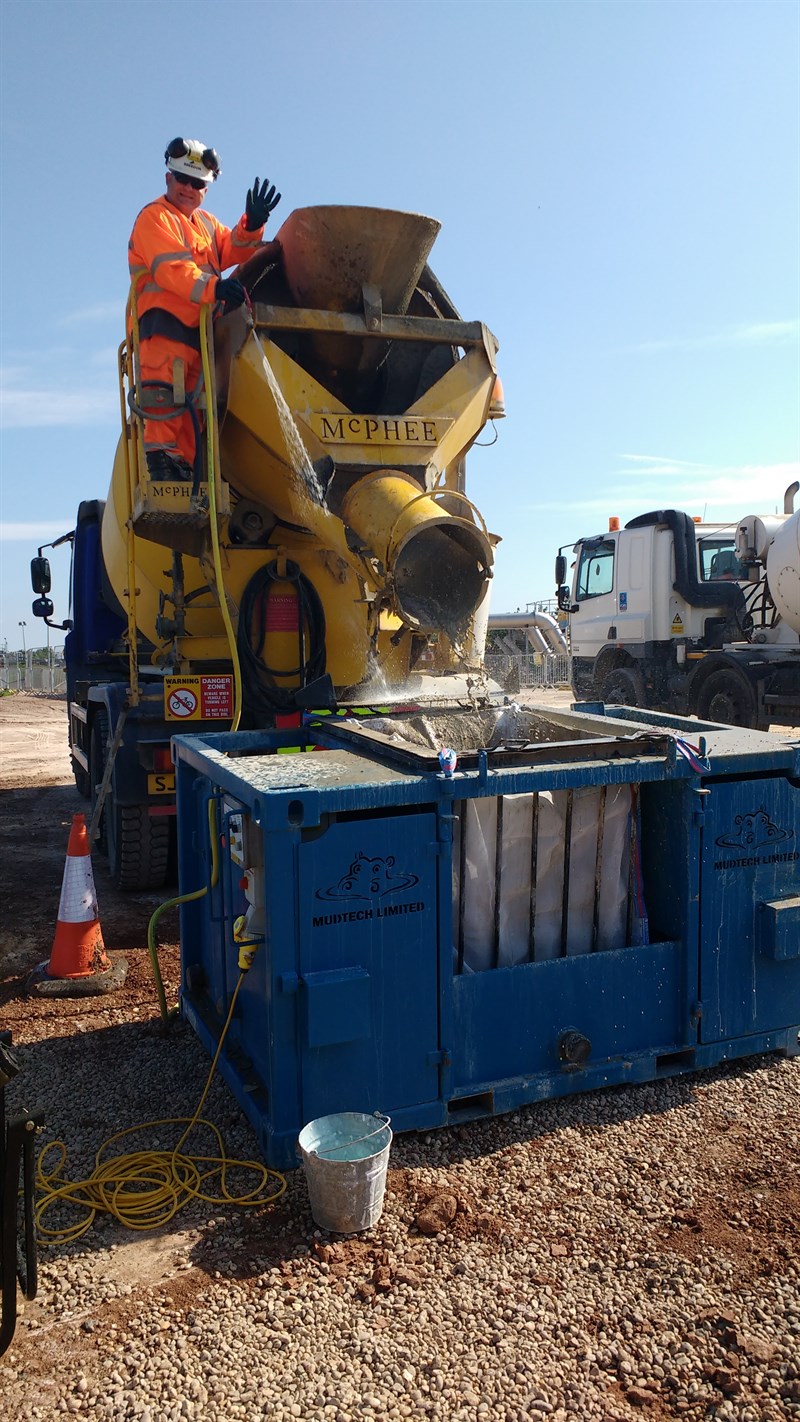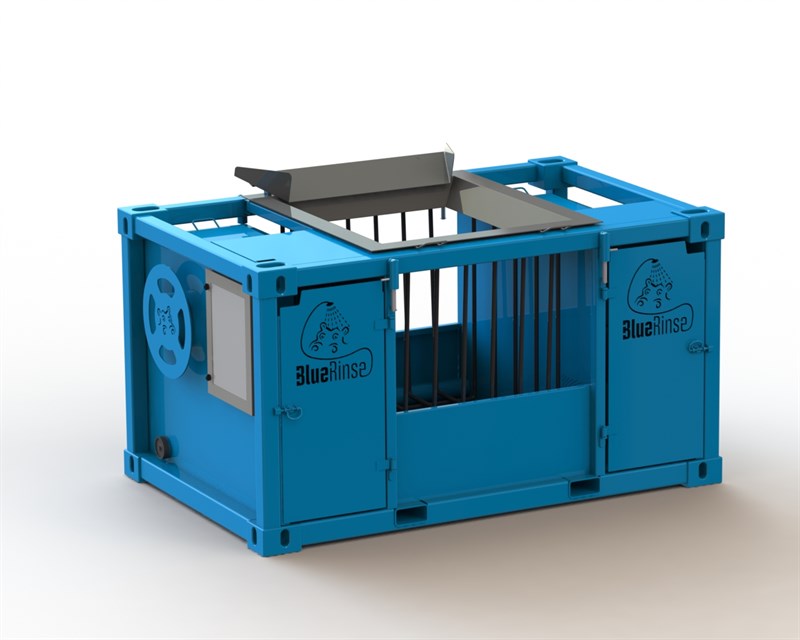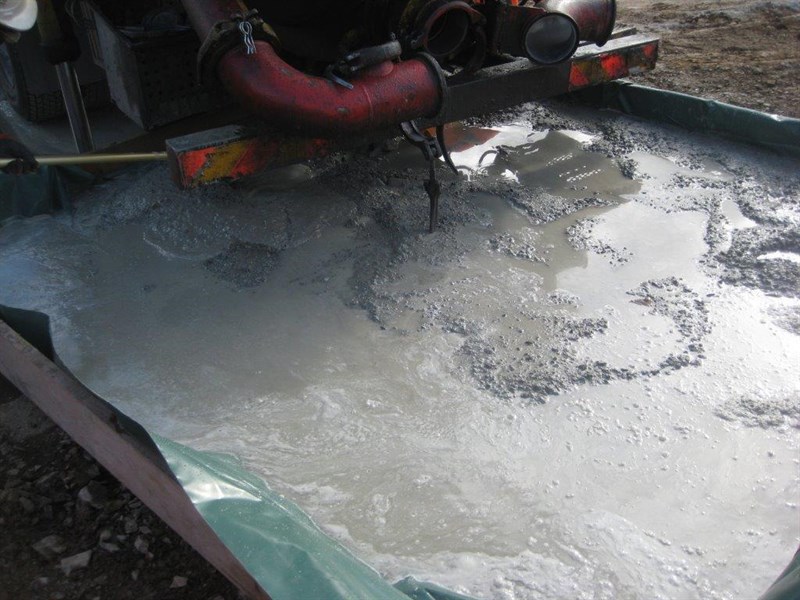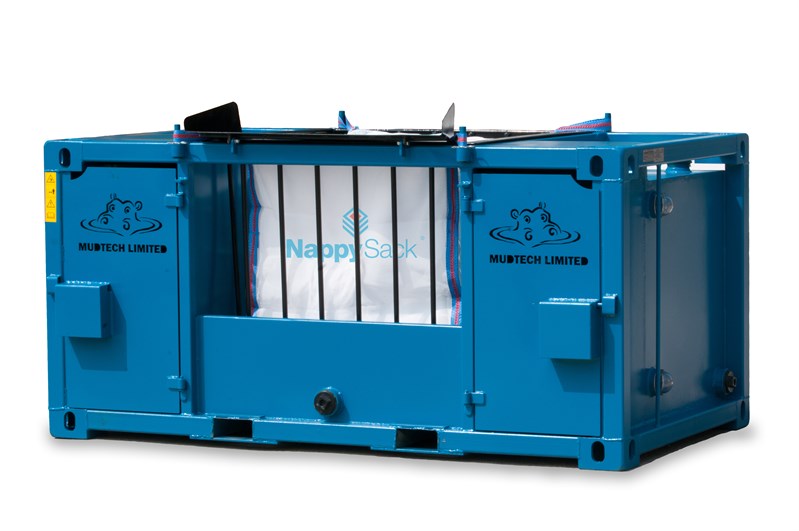For BlueRinse Concrete Washout
enquiries
Contact our Tank Division on
Telephone +44 (0)1785 600389
Safe and Tidy Concrete Washout on Site
We have a new dedicated website www.bluerinse.co.uk

Mudtech's BlueRinse System for concrete washout.
High pH washwater arising from concreting activities is
becoming a significant Environmental Aspect

It is important that an Environmental risk is not simply
converted into a Health and Safety hazard.
|

When water is used to wash the chute on a concrete wagon, for
example, the water is in contact with the cement for a very short
time. The pH of this water will hardly be raised at all. If both
the water and the concrete are washed into a skip, however, the
water will continue to rise in pH with typical values of 12 and
above. This is enough to present significant CoSHH issues, cause
concrete burns to skin and damage eyes. The water will often appear
clean and if left in a skip may even appear inviting to a child to
swim in.

Please note
-
It is the water with raised pH that is the pollutant here not
the solids
-
The pH of the water continues to rise when it is in contact
with green cement
-
Once the concrete has cured it is safe
-
Water rarely evaporates from containment skips or bunds it must
either be treated prior to discharge or disposed of according to
current legislation; by a licensed contactor with a documented
waste trail. Failure to do this would indicate deliberate release
to our environment, which is an offence. A competent auditor
or official from a regulating body would identify this easily.
Actions
-
Reduce time washwater is in contact with cement
-
Remove solids from standing water as soon as possible
-
Recycle water in order to reduce water consumption and
wastewater disposal
-
Maintain pH to below 10 to reduce the risk of harm to
workforce, the public and our environment
-
Reuse cured solids as hardcore or dispose of as non hazardous
concrete waste 17-01-01
-
Dispose of treated (pH below 10) washwater to foul sewer with
consent from sewerage undertaker
We at Mudtech's Tank Division have looked at current practice
Worldwide for a safe simple and effective way to achieve the
requirements identified in the actions above.
We have found that most solutions offered do not address the
main problem, the water. Many simply contain the washings and just
leave liquid waste on site along with all the associated handling
issues.

Treatments available to reduce pH include
Treatment agents
|
Advantages
|
Disadvantages
|
Acidics
|
Fast acting: accurate pH target can be achieved with careful
control
|
Serious CoSHH issues: easy to overdose forming an acidic
hazardous material. Risk of serious pollution event or violent
chemical reaction.
|
Carbon Dioxide
|
Effective; accurate pH target can be achieved with simple
control. CO₂ is self limiting and will not lower pH to form a
strong acid. pH will not fall below 6.4.
|
Pressurised gas has handling issues on site. It can be wasteful
and difficult to predict consumption.
|
Mudtech's pH Blue
|
Effective pH control will not lower pH below 8 so self
limiting. Safe to handle and store on site and is readily
soluble
|
Will only lower pH to a level that is safe to discharge to the
environment or foul sewer. It is not possible to target a pH below
8.
|

-
Reduces the time washwater is in contact with cement (as water
is washed into a Plant Nappy Sack).
-
Removes solids from standing water as soon as possible (as
water is drained from the sack into a receiving tray)
-
Recycles water in order to reduce water consumption and
wastewater disposal (water is returned to the tank where it is
continually used to wash further chutes or equipment by means of a
high pressure hose fed by an on-demand pump).
-
Maintains pH to below 10 to reduce the risk of harm to
workforce, the public and our environment (pH Blue mixed at a 10%
solution will maintain the pH to below 9. When the pH rises another
25kg keg can be added to the main tank).
-
It is possible to reuse cured solids as hardcore or dispose of
as non hazardous concrete waste 17-01-01 (the specially designed
Plant Nappy Sack can be lifted from the frame and allowed to drain
further on site the water will not be hazardous. It can then be
emptied; the drained solids will then be safe for reuse or
disposal).
-
Dispose of treated (pH below 10) washwater to foul sewer with
consent from sewerage undertaker. (Water treated with pH blue and
remaining in the tank at the end of the job can be released to land
or allowed to flow into a foul sewer; because this water is used in
a closed loop quantities will not need to exceed 500 litres).
For BlueRinse Concrete Washout
enquiries
Contact our Tank Division on
Telephone +44 (0)1785 600389